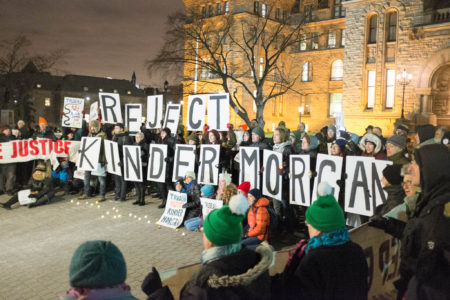Every year, Massey College holds a (more serious) Coffee House and (more silly) Tea Hut talent show.
Category: Photography
Equipment, examples, history – all matters photographic
Climate leaders don’t build pipelines
Tonight Toronto350.org organized a vigil to resist the Kinder Morgan pipeline expansion, which took place along with 44 others across Canada.
Justin Trudeau is going to find that his promises about indigenous reconciliation and restoring Canada’s environmental reputation require him to stop further bitumen sands extraction and export. If not, he will end up as confounded as the Harper government.
Environmental scholars
I photographed a workshop of environmental scholars at UTM.
Massey Halloween
Massey produced another crop of strong Halloween costumes this year.
Science policy symposium
I photographed Massey College’s first annual forum on science policy, held in honour of Ursula Franklin.
I previously shot this video commemorating Dr. Franklin.
Brexit panel
Today I photographed a panel on Brexit hosted by the Canadian Centre for the Responsibility to Protect (CCR2P).
Welcome BBQ
The history of the Arab Spring
The New York Times has published an exceptional long article by Scott Anderson about the history of the Middle East since 2003. It’s an ambitious text to have written, not a trivial task to read, and perhaps a suggestion that print journalism is enduring in its dedication to telling complicated stories, despite ongoing challenges to the business model and staffs of many of the most important print sources. It also includes some remarkable photography by Paolo Pellegrin.
A summary, early in the article, attributes special importance to the post-Ottoman settlement:
Yet one pattern does emerge, and it is striking. While most of the 22 nations that make up the Arab world have been buffeted to some degree by the Arab Spring, the six most profoundly affected — Egypt, Iraq, Libya, Syria, Tunisia and Yemen — are all republics, rather than monarchies. And of these six, the three that have disintegrated so completely as to raise doubt that they will ever again exist as functioning states — Iraq, Syria and Libya — are all members of that small list of Arab countries created by Western imperial powers in the early 20th century. In each, little thought was given to national coherence, and even less to tribal or sectarian divisions. Certainly, these same internal divisions exist in many of the region’s other republics, as well as in its monarchies, but it would seem undeniable that those two factors operating in concert — the lack of an intrinsic sense of national identity joined to a form of government that supplanted the traditional organizing principle of society — left Iraq, Syria and Libya especially vulnerable when the storms of change descended.
This accords closely to Middle Eastern history as interpreted by many of the sources we read in my Oxford M.Phil. In particular, it reminds me of David Fromkin’s A Peace to End All Peace: The Fall of the Ottoman Empire and the Creation of the Modern Middle East.
Anna Luengo retirement
On Friday, I had the good fortune to see a number of rarely-seen Massey friends at Anna Luengo’s retirement party.
Talisker Players
I did a really fun photoshoot today, with the Talisker Players.


